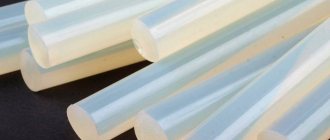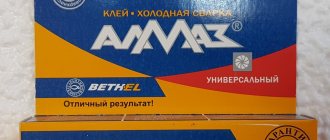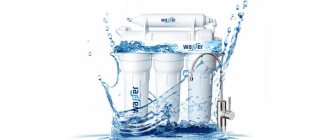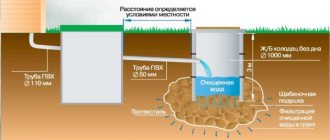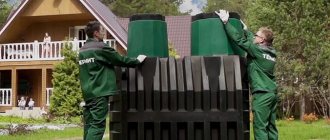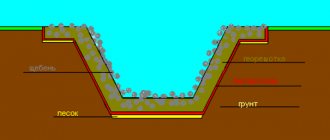Traditional flour paste recipe
In some cases, this is resorted to when there is an urgent need to perform any work related to the use of glue. For example, if the amount of adhesive is incorrectly calculated, and it runs out in the midst of wallpaper renovation work. In order not to give up what you started and not rush to the store, you can make homemade glue, the quality of which will be much higher than purchased glue. In addition, when using it, you can be completely sure that it does not contain substances harmful to humans. It’s not difficult to prepare, and the material can always be found in the house. This is wheat flour. Flour glue is prepared at the rate of 1 liter per two or three rolls of wallpaper.
To prepare it you will need:
- container, the volume of which depends on the required amount of glue,
- flour – 6 tbsp. spoons per liter of water,
- water – 1 liter.
Cooking method:
- Heat water to boiling.
- In a separate bowl, dilute the calculated amount of flour in a small amount of cold water until a homogeneous mixture (without lumps) is formed and liquid sour cream is thick.
- Pour the resulting mixture into boiling water in a thin stream, stirring constantly.
- Bring to a boil again and leave to cool.
When finished, it should have the consistency of thick jelly. Similarly, you can make glue from starch, which is no different in quality from flour paste. In terms of gluing efficiency, both flour and starch pastes, in some cases, even surpass ready-made industrial adhesives. Wallpaper glued with them adheres perfectly to any wall surface. They can glue all types of paper and cardboard.
How to get the right taste and consistency
The pastry glue should have a neutral taste and smell so as not to overwhelm the main dish. A fixative that is too thick or liquid, or a composition with lumps will not provide a reliable connection and will spoil the appearance of the product.
Little things that affect taste and consistency:
- Sometimes the powdered sugar clumps together, forming one big lump. Take the time to crush it as finely as possible. Otherwise, the mastic will tear when rolling.
- Do not apply the pastry mixture to the soaked cake layer, only to the dry cake layer. The glue may dissolve due to the large amount of sugar.
- If you are using buttercream, let it cool thoroughly in the refrigerator before applying the mastic.
- Decorate the cake shortly before serving, otherwise the figures will get wet and stop holding their shape.
- If some elements dry out while decorating the cake, place them in the microwave for a few seconds. This will return them to their previous state.
Mastic can be stored in the freezer for up to two months, and in the refrigerator for no more than two weeks.
PVA glue at home
The most common glue, which is popular not only when performing home renovation work, but also in large-scale construction, is PVA glue. This is an excellent wallpaper adhesive; it is successfully used in the preparation of mortars for tiling, as well as as a primer for surfaces before final finishing. The scope of its use is so wide that we can say with confidence that polyvinyl acetate is a kind of lifesaver for a zealous owner who can make PVA glue with his own hands.
To do this, he needs to have:
- One liter of distilled water,
- 5 g photographic gelatin (sold in Photography stores),
- 4 g pharmaceutical glycerin,
- 100 g wheat flour,
- 20 mm ethyl alcohol (can be bought at a pharmacy).
The preparation of glue takes place in two stages:
- preparatory, during which gelatin is soaked in a glass of water for a day;
- main
After the gelatin has swollen in water, you can proceed directly to preparing PVA glue:
- A container with distilled water is placed in a water bath. Prepared gelatin and flour mixed with a small amount of water (so that there are no lumps) are added to it.
- The entire mixture is brought to a boil (*do not boil!). It should become like thick sour cream. In order for the mixture to be homogeneous, it must be stirred constantly.
- Add glycerin and alcohol. To obtain a thick mass of homogeneous composition, the mixture must be thoroughly mixed. This may take from five to ten minutes (depending on the amount of glue being prepared). To be completely ready for use, the glue must be cooled.
Additional options
Less often, users try to make other types of glue that serve as an alternative to store-bought products.
Glue stick
The glue stick is made from PVA. For the case, you need to take an old antiperspirant deodorant package that closes tightly. Make laundry soap (2 parts), add water (1 part). Dissolve in a water bath, pour in 4 tablespoons of PVA, cool. Then put the mixture into packaging and let it harden.
Super glue
Of course, it is impossible to make real super glue - it is prepared from cyanoacrylate with the addition of a number of complex chemical components. But you can still create a very reliable composition with your own hands. For this you will need:
Sugar is dissolved in water, lime is added, and heated for 30 minutes in a water bath. Next, crushed wood glue is placed into the solution and boiled until the mass is homogeneous. The product can be used for gluing metal, ceramics, porcelain.
Foam glue
Wood glue is best suited for gluing foam plastic. Casein glue is also suitable, which is mixed in equal parts with slaked lime. This product is ideal for fastening polystyrene foam when insulating a house.
Foam glue
Glue is made from acetone and polystyrene foam to join elements of glass, metal, and wood. The foam is crushed into crumbs and poured with acetone to completely cover it. A viscous mass is obtained almost immediately; it can be used like regular glue, after mixing well.
When making adhesives with your own hands, you can save a lot of money, especially if you are planning a major renovation of your house or apartment. The quality of the finished product may be somewhat inferior to the store-bought product, but it will definitely be safe for health and affordable!
Source
DIY wood glue
This is the best glue for wood. It effectively glues paper, cardboard and other materials. But it has several features:
- it cannot be stored for a long time in liquid form, as it deteriorates very quickly (it becomes moldy and gels),
- it has a disgusting, pungent smell.
Therefore, it is pre-boiled and a gelatinous mass is prepared, which has a longer shelf life. If necessary, pieces of the required size are cut and dissolved, heating over low heat. There are several ways in which you can prepare high-quality wood glue at home. The most accessible are the following.
Method No. 1. Take regular wood glue. Grind and soak it in a container of water until completely swollen. It should become soft, resembling jelly. This jelly is placed in a melting container called a gluebox. You can make it yourself from an ordinary tin can. The oilcloth with the gelatinous mass is placed in a water bath and placed on very low heat. The mixture must be constantly stirred with a wooden stick. If it burns, the glue will turn yellow and lose some of its adhesive properties. After the gelatinous mass turns into a liquid state, it is diluted with vodka in the ratio: per 720 g of glue - 950 g of vodka. And for every hundred grams of glue, twelve grams of powdered alum are added. Wood glue obtained by this method provides high strength to the bonded surfaces and water-repellent properties.
Method No. 2. Boil wood glue and water in a 1:1 ratio in an oilcloth. After boiling, when it begins to thicken slightly, pour the mixture into a porcelain mortar and grind with a pestle until a gelatinous mass forms. After this, place this mass on a special plate, cool and cut into pieces. If necessary, dissolve 720 g of the resulting workpiece in a solution consisting of 720 g of water and 360 g of vodka. Bring the mixture to a boil.
Method number 3. In a water bath, boil 1 kg of wood glue and 1 liter of 9% table vinegar in a liter of water until it is completely dissolved, then add a liter of vodka with constant stirring.
Method number 4. Dilute wood glue with water in a ratio of 1:1.
Heat in a water bath until completely thickened. Then add one weight part of glycerin equal to the originally taken weight part of the glue. Heat until the water evaporates completely. Place in molds and dry. For use, dilute with water (1:1).
Cooking methods
Some formulations are prepared by simply mixing the ingredients. Others require heating, cooking or long-term aging of substances to dissolve in each other. In any case, it is important to strictly observe the proportions of the components, otherwise the finished homemade glue may not be of good enough quality.
Wallpaper glue made from flour
Of course, buying ready-made wallpaper glue is much easier. But sometimes it happens that it ends at the wrong moment, and it is quite possible to re-glue the material with a paste of your own making. The same composition is suitable for working with papier-mâché. The recipe is:
You can start gluing the wallpaper immediately after the product has completely cooled. This amount is enough for 2 rolls of canvas. The glue is best suited for simple paper, lightweight non-woven wallpaper on a paper base. For vinyl and other heavy materials, it is better to buy ready-made glue.
PVA at home
Domestic PVA and imported Elmers are water-based products containing polyvinyl acetate and plasticizers. Depending on the purpose (office, household, universal, construction), other substances can be added to the PVA composition. The product has a white or beige color and is distinguished by its ability to freeze and defrost without loss of quality. Using PVA in diluted form you can prime walls, and in its pure form it is used for gluing heavy wallpaper.
You can make PVA using this method:
If necessary, glue that is too thick can be diluted with cool distilled water and mixed thoroughly. The finished composition should be stored in convenient jars, under a lid, at a temperature of +10...+15 degrees for up to six months.
Epoxy adhesive
It cannot be prepared from improvised means. In any case, you will need liquid epoxy resin and a hardener, which must be mixed together in certain proportions. Epoxy is a transparent composition that is sold immediately with a hardener. As mixing proceeds, the polymerization reaction begins, before the end of which it is necessary to apply the composition to the desired surface. Due to its reliability and excellent adhesion, epoxy adhesive is most often used:
Typically, 4 parts of hardener require 6-8 parts of resin; more precise recommendations are always indicated in the instructions. After combining the material, it is used immediately or heated slightly by placing the container in hot water. Then use the product to repair various products. It glues the most durable ettrol-based plastics, PVC, glass and metal products.
Rubber glue
This product is used for gluing rubber products. Some people try to do it this way: they cut up pieces of an old car tire and fill them with gasoline. In fact, cross-linked tire rubber does not dissolve well in gasoline and other organic solvents because it contains sulfur. Therefore, the ideal option is to take raw rubber, which is used in tire repair with further vulcanization. Gasoline should also not be ordinary, but aviation grade, then the glue will be of excellent quality.
The procedure for creating a tool is as follows:
Instead of raw rubber, black soles of old shoes are suitable as filler. It is only important that they are made of TEP (thermoplastic elastomer), which is used for the production of so-called molded shoes.
Wood glue
This adhesive composition is used to fasten wooden products. It can also be used for gluing paper, cardboard, fabric, and a number of other materials. Its downside is that after long-term storage it will begin to gelatinize, become moldy, and become covered with a hard crust. The finished product does not have a very pleasant smell, which is also its disadvantage.
Wood glue is a gelatinous mass, quite dense in consistency. Pieces are cut from it, which are heated and used for gluing parts. It is important to heat the mixture over low heat to prevent it from boiling. There are several options for making the product. For any of them, you need to purchase dry wood glue, which is sold in the form of granules or yellowish tiles. It is prepared from tannery waste, bone meal, animal horns or fish remains.
Popular cooking recipe:
This product has water-repellent properties and gives the glued products high strength. Wood glue is also made according to a different recipe:
You can also dilute the glue with water 1:1, then add the same amount of glycerin as dry glue powder was taken. Then you need to heat the mass in a water bath until the liquid evaporates. Afterwards you can immediately use the glue. For storage, it is dried, and before use it is simply allowed to swell in water.
Casein glue
Casein is a complex protein that is obtained from caseinogen during the curdling process of milk. Casein glue is used for gluing leather, wood products, paper, and cardboard. To make such a substance, you need to isolate casein from cottage cheese by defatting:
Foam glue
Currently, foam and polystyrene plates are often used for insulation and soundproofing of residential premises. They are glued to the load-bearing wall. When choosing glue for polystyrene foam, you must take into account that solvents, such as acetone, can melt it. Therefore, the ideal option for it is the above-mentioned wood glue.
But, at home you can make another waterproof glue for polystyrene foam - from cottage cheese:
- To do this, mix lime (slaked) with cottage cheese in equal proportions until a homogeneous mass is obtained. It is advisable to use this glue immediately after preparation, as it hardens quickly.
Main components of edible glue
Food fixative is made from edible ingredients. When consumed in moderation, it does not harm a person in any way.
The main components of factory-made edible glue:
- Water.
- Preservative: citric acid.
- Food additive E 466 - used as a thickener to give the product a viscous structure. It is usually used in the production of yoghurts, curd products, and cheeses.
- Potassium sorbate is a harmless additive E 202. It increases the shelf life of products by inhibiting the growth of mold, fungi and yeast.
Sugar glue is produced in the form of powder for preparation and a ready-made jelly-like mixture. The minimum price starts from 50–70 rubles per 100 grams.
Popular brands of confectionery fixative:
- Magic Colors. Produced in Israel. It has a very reliable fixation and is used for gluing massive objects. The adhesive force allows you to hold even marzipan figures. Suitable for masking defects on the surface of a product. Sold ready-made. It is a thick viscous substance.
- Rainbow edible glue. The choice of professional confectioners. Neem is used to hold together complex designs and multi-layered desserts. The glue has no taste or smell. It can be eaten by allergy sufferers and vegans, as it does not contain any components of animal origin. Country of origin: Great Britain.
- CMC (food grade carboxymethylcellulose). The powder is tasteless and odorless. Before use, it must be mixed in water. Used for making mastic.
- Full name: Essentials Edible Glue. Created on a plant basis. Suitable for manufacturing and fixing large, heavy parts.
Casein glue for leather, wood and even puzzles
A good option for gluing wooden and leather products, as well as other materials, is casein glue. It can be successfully used in surface treatment for puzzles.
Stage 1: isolation of casein from cottage cheese
To prepare it at home, the cottage cheese must go through a defatting process. To do this, you need to soak it in a soda solution (1-2 tablespoons of baking soda per liter of water) for 15-20 minutes. Then it is thoroughly washed with running water, wrung out and dried until hard. Next, a powder is prepared from it. This is dry casein.
Stage 2: prepare glue from dry casein
dry casein
To prepare glue from casein, you need to pour the powder into any container (preferably flat) and add water in a thin stream, stirring constantly. Take two parts water to one part casein powder. You should get a thick mass. The most crucial moment in preparing casein glue is its further mixing until it becomes homogeneous. The better the mass is mixed, the higher the quality of the glue. This procedure will take at least 30 minutes. But the process can be speeded up if you use a regular mixer. This is an excellent wood glue. It has excellent leather bonding properties and is well suited for shoe repair. The disadvantage of this glue is that it must be used within two to three hours, after which it hardens and becomes unsuitable for further use.
BF series compositions and cyanoacrylate glue
Under the BF brand you can find several types of adhesives. BF 2 and BF 4 have good adhesive qualities in relation to wood and other materials. They are characterized by rapid drying. Provided normal humidity and temperature, this takes no more than 60 minutes.
It is recommended to use BF 2 for gluing wooden surfaces located indoors. It is endowed with resistance to heat and moisture. BF 4 is characterized by resistance to low temperatures and good elasticity. This composition is also moisture resistant, but is intended for outdoor use. They must be carried out in 2 layers, the interval between works is 15 minutes. There are certain requirements for wood; it must be degreased and thoroughly cleaned before gluing.
Cyanoacrylate glue is the most expensive. This so-called second glue is available in thick, medium and liquid consistency. Liquid is able to penetrate into the smallest cracks, thick - into small gaps. If you combine it with an accelerator, it glues almost instantly. This type is convenient to use for temporary fastening, since the glued surfaces are destroyed if there is a sharp blow to the side of the adhesive seam. But such fast setting is convenient in that the element can be fixed in place until another strong adhesive sets.
Glue for needlewomen
Today, needlework is one of the most common women's hobbies. Women are increasingly interested in making flowers, using various types of fabric. Flowers whose petals are glued to each other look most impressive and elegant. For this, a special fabric glue is used, which can be prepared in several ways.
Method one
Components:
- 3 tbsp. spoons of wheat flour,
- one glass of water.
Preparation:
- Dilute the flour in a small amount of cold water and pour in a thin stream into a glass of boiling water. Boil.
Method two
Components:
- one tbsp. spoon of wheat flour,
- one tbsp. spoon of potato starch,
- one tbsp. spoon of granulated sugar.
- one glass of water.
Preparation:
- Mix all ingredients thoroughly so that there are no lumps and bring to a boil.
Method three
Components:
- gelatin packet,
- 2 tbsp. spoons of flour,
- granulated sugar - one tbsp. spoon,
- water - one glass.
Preparation:
- Soak the gelatin overnight by adding water (1/3 cup). In the morning, in the remaining water (2/3 cup), stir the swollen gelatin, flour and sugar. Boil.
Fabric glue should be stored in the refrigerator in a hermetically sealed container.
Recommendations for preparing glue
- Flour glue is a universal means for gluing wallpaper. But with a wide variety of wallpapers, it is necessary to take into account their density and know how to make high-quality material. If the wallpaper is dense and heavy, increase the amount of the main component. The thicker the consistency, the better it will hold. Depending on the wallpaper you will need from 300 to 500 g.
- To prepare the primer solution, take a smaller amount of base, about 100 g. It is recommended to add copper sulfate (1 g) so that it has antiseptic properties.
- To strengthen the properties, you can pour in ethyl alcohol or denatured alcohol. Turpentine will also increase stickiness; a standard recipe requires adding 125 ml of turpentine.
- The paste will become easier to use by adding glycerin (4 g) or gelatin (5 g). The grip will be stronger.
- In the paste, the main component can be replaced with starch, or a solution can be prepared by mixing with starch.
Necessary ingredients: flour - a glass, starch - 35 g, water - 2.5 l.
Action plan:
- Dilute everything in cold water, mix thoroughly;
- boil water, slowly pour in the solution;
- Boil the mixture and let it cool.
Important ! Use available means: natural, cheap. Repair and enjoy the result. After all, nothing pleases the eye more than quality work done.
Excellent dextrin based paper adhesive
For origami, quilling, and paper appliqué, dextrin paper glue, which you can prepare at home, is ideal. And for this it is not at all necessary to look for dextrin in stores. It is easily prepared from starch. You need to take it in the required quantity. Place in a heatproof bowl into a slightly heated oven. After which, gradually increase the temperature to 160ºС and maintain at this temperature for about an hour and a half. Under the influence of hot air, starch is broken down, and it turns into dextrin. Now you can start preparing the glue.
Ingredients:
- dry dextrin – 3 tbsp. spoons,
- water – 4-5 tbsp. spoons,
- glycerin – 1 tbsp. spoon.
Preparation:
- Mix dextrin powder with water. Heat slightly until the dry substance is completely dissolved, stirring continuously. Then add glycerin.
Which glue to buy for plastic models
Models of any complexity are made from plastic - airplanes, ships, cars. High-quality glue for this material should not spread over a smooth surface, so it must be selected carefully.
There are many manufacturers producing adhesives specifically for plastic. So, you can safely use polystyrene compounds from Revell, Italeri, Tamiya, Zvezda. Despite the similarity of properties, they can be divided into three groups:
- Liquid - sold in polyethylene bottles with a convenient applicator.
- Medium density - presented in glass jars with a brush on the lid.
- Thick ones are packaged in tubes. They harden the slowest, so they allow you to work without rushing.
Once applied to the parts, polystyrene mixtures penetrate inside and harden, forming a strong connection.
You can use the glued parts within an hour, but the product will finally set within a day. Revell adhesives for plastic products are sold in cans with a needle, Tamiya equips the cans with a brush, but Zvezda adhesives are supplied to stores without additional tools.
What rules must be followed when working with glue for prefabricated models?
- You should not add too much mixture to the junction of parts; you risk staining your hands, tools and the parts themselves with the leaking excess,
- if a drop gets on a part, do not try to wipe it off, wait until the composition dries and sand this area,
- the liquid glue should not get under the masking tape, otherwise after completing the work and removing the film you will find that the plastic
- the place where the super glue is connected turns out to be fragile, so it is better not to touch it, you can additionally degrease it,
- follow the instructions for use indicated by the manufacturer on the packaging,
- use the products strictly for their intended purpose and only for the materials for which they are intended,
- When working with toxic compounds, it is recommended to use protective gloves.
Turbo glue made from acetone and old linoleum
There are still many different techniques that contain tips on how to make glue at home. Among them there is a very affordable way to prepare universal glue without much expense - from acetone and old, already worn out, linoleum.
How to make it:
- Cut the linoleum into small pieces, which are placed in a container with a hermetically sealed lid.
- Fill with acetone. In this case, there should be twice as much acetone as linoleum.
- Close the container with a tight lid and place in a dark place for 12 hours.
- The glue is ready for use when the pieces of linoleum are completely dissolved.
This glue is excellent for gluing metal, porcelain, wood, leather, etc.
Bonus from builders for cooks: food glue
Nowadays, many people are fond of home baking and decorating it with sweet figures and various flowers made from edible mastic. But in order for all this beauty to retain its shape and stick to the surface of the cake, special food glue is required. Of course, you can buy it at the store, but before you go looking, try making glue at home. There are several recipes for this.
Recipe No. 1: based on starch
Components:
- starch - 4 tbsp. spoons,
- water – 1 glass.
Preparation:
- Prepare a thick starch jelly and leave it in a warm place for several hours. It should turn into a viscous mass.
Recipe No. 2: sugar glue
Components:
- 250 g granulated sugar,
- Glass of water.
Preparation:
- Prepare a slightly undercooked caramel toffee. It should remain in the form of a stretchy liquid.
Use of starch
When making starch-based glue, you should prepare half a liter of water and 3 tablespoons of corn starch. As a container, it is better to use galvanized or enameled dishes, which are placed on the fire along with water until it boils. Starch should be dissolved separately, and then, as in the case of flour, poured into the liquid.
When the glue boils, it can be removed from the heat. The main advantage of this composition is that it is more transparent and leaves no traces. It should be used without reserve, because over time it will lose its ability. In order to improve the quality of the glue, it is recommended to add about 100 g of PVA glue to it. But if you also add wood glue, the mixture will cope with priming surfaces before gluing wallpaper.
